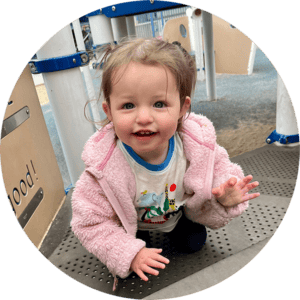Our lives shattered on July 10th, 2023. That day, our perfectly healthy seven-month-old baby girl was rushed to the hospital for a complex seizure – one that was so difficult to control, doctors had to intubate her to get it to stop. What we hoped was a one time febrile seizure instead became a recurring nightmare. Genetic testing confirmed a SCN1A mutation, and Mila was diagnosed with Dravet syndrome in early November 2023, just weeks before her first birthday. In those dark days post diagnosis, it felt like all our dreams for our family were over.
Mila spent many weeks in the hospital during her first year of life. She has been intubated twice and has had seizures that have lasted close to an hour. Several times, we have stood by helplessly, fearing for her life, as doctors struggled to control her seizures. Mila is on three daily medications to manage her seizures. Despite these medications, Mila still has upwards of 45+ myoclonic seizures each day. Mila has fallen behind on milestones, but we believe in her and are doing everything in our power to help her. She attends multiple therapies every week including physical, occupational, and speech therapy.
State of Science
In 2023, Dravet Syndrome Foundation awarded $1M–its largest grant to date–in support of the Dravet Genome Study, a major 3-year initiative being carried out by researchers at The Children’s Hospital of Philadelphia (CHOP). Researchers aim to generate whole genome sequencing (WGS) data for 500 individuals with Dravet syndrome, paired with clinical information, to investigate how genetic variations influence outcomes like seizure frequency and development. This three-year project will focus on data sharing and privacy, creating a valuable resource to better understand Dravet syndrome and guide new treatments.
“This transformative grant from the Dravet Syndrome Foundation will support the generation of an invaluable resource of clinical and genetic data to me made available to the research community to accelerate advances in the field of Dravet syndrome for patients and their families.”
– Dr. Ethan Goldberg, Director of the Epilepsy NeuroGenetics Initiative (ENGIN) at The Children’s Hospital of Philadelphia (CHOP)
Mila cannot yet walk but scoots like crazy and is surprisingly quick. She is not very verbal, but extremely communicative in her facial expressions (just like her mom). It is very clear what she likes (strawberries) and what she doesn’t (avocados). Although she is often the smallest and least coordinated toddler on the playground, other kids will hide their toys from her because she is so excited to play.
When Mila thinks something is funny, she gives you a meaningful sidelong glance as if to say “did you see that?” Mila has a striking ability to charm complete strangers and get their attention with her toothy little grin and ecstatic waves. Our first and only child, Mila is now a bright and happy toddler who loves balloons, slides, ice cream, flowers, and taking long evening baths with lots of bubbles.
Mila’s days are filled with love and joy. However, Dravet is a constant source of fear and anxiety for our family. Because we never know when a seizure will present, we are always on guard. Every day requires thorough planning and constant attention to prevent seizures. Every night requires specialized monitoring devices to protect against Sudden Unexplained Death in Epilepsy (SUDEP), a condition that disproportionately impacts those living with Dravet. At every turn we must manage the opportunities to see Mila explore and grow, with the very real fear of a seizure episode.

Before DSF: Families like Mila’s often endured years of misdiagnoses and ineffective treatments, delaying proper care and increasing suffering.
With DSF: The Dravet community now benefits from advancements in genetic testing, early diagnosis, and access to new, specialized medications.
Hope for the Future: Mila’s family hopes for more research breakthroughs, improved treatment options, better seizure control, and ultimately, a cure for Dravet syndrome.
As a family we face the constraints brought on by medical expenses, as well as the career implications of being full time caretakers to someone with such involved and complex medical needs. The trauma and the psychological burdens of living with this syndrome are both very current and lifelong: we spend a lot of time reflecting on anticipatory grief and how we can live as best we can in the here and now.
We are so proud of Mila and everything she has accomplished. We live in that very strange space between hope and fear – remaining positive about the research breakthroughs occurring while managing the risks the best we can. We will never stop fighting for Mila – and all of those affected by this devastating condition. It is possible that we will see a cure for Dravet in our Mila’s lifetime – but that possibility will only become a reality with support from those who love and believe in children like Mila.

